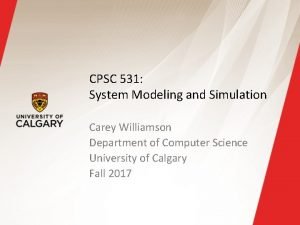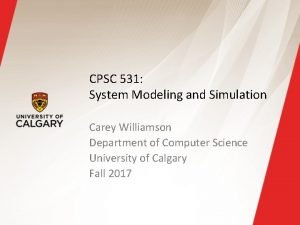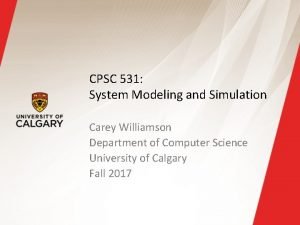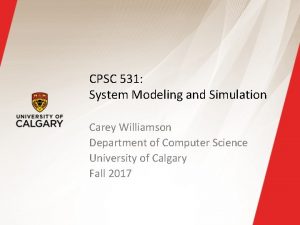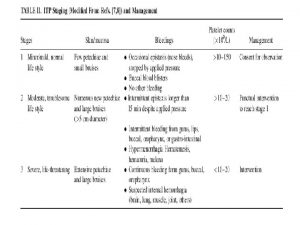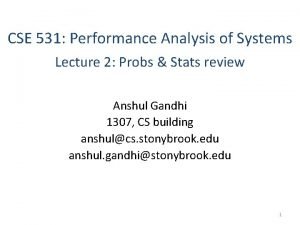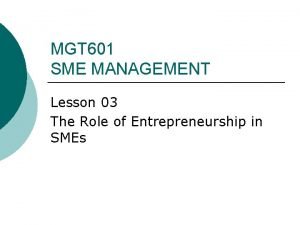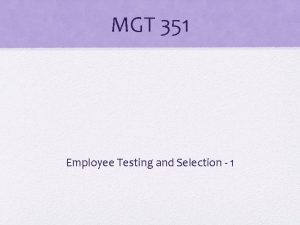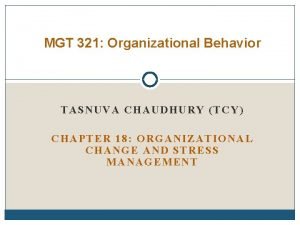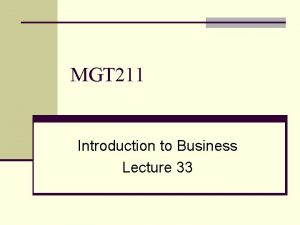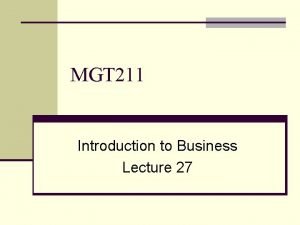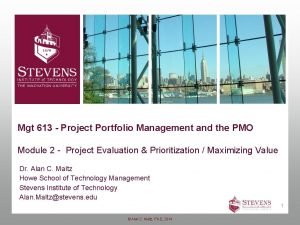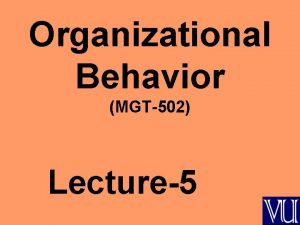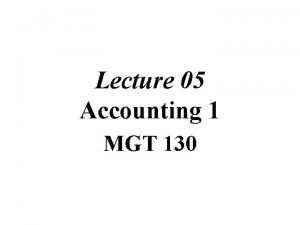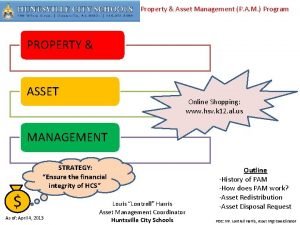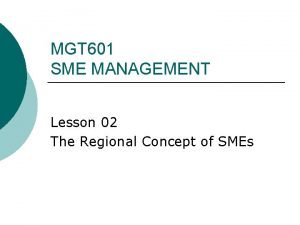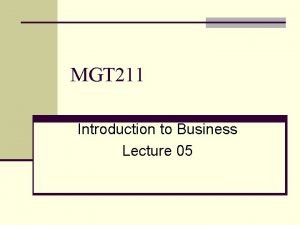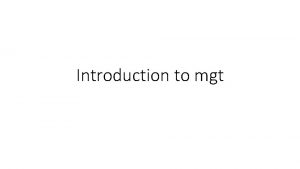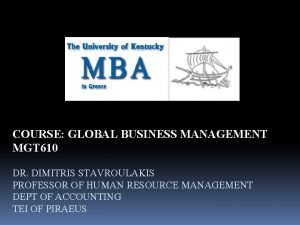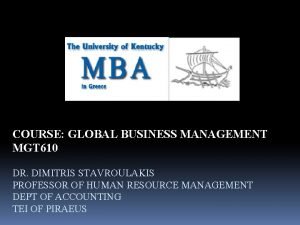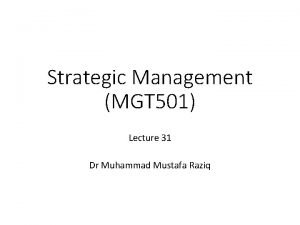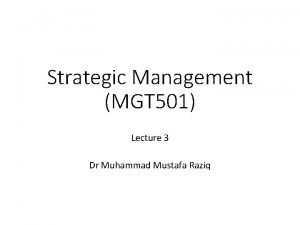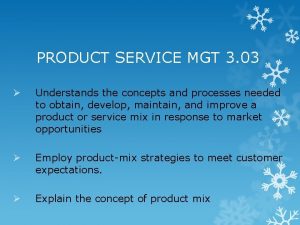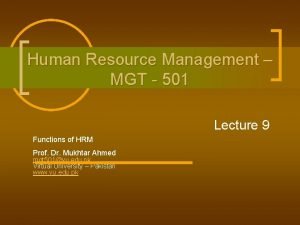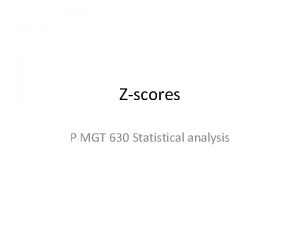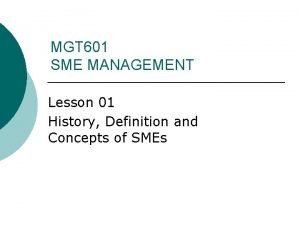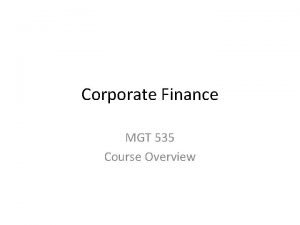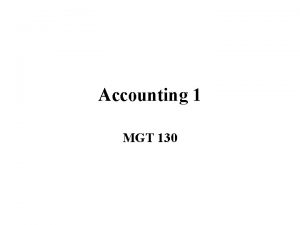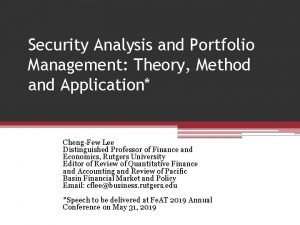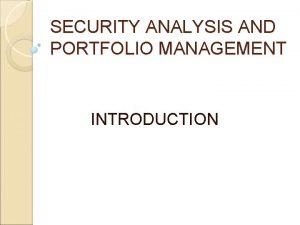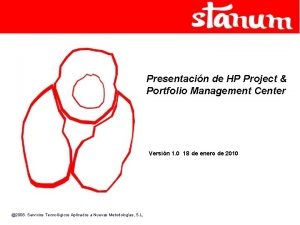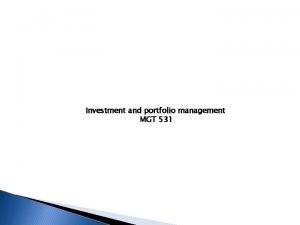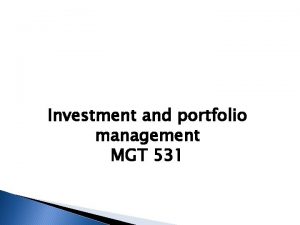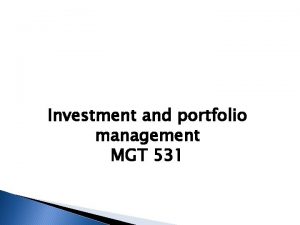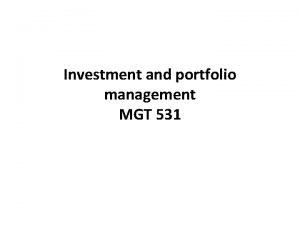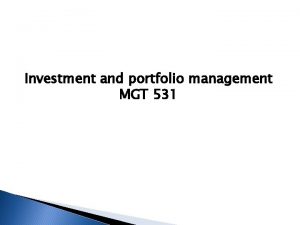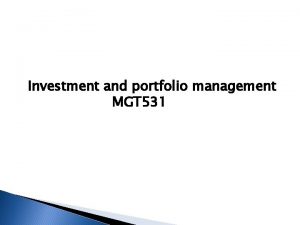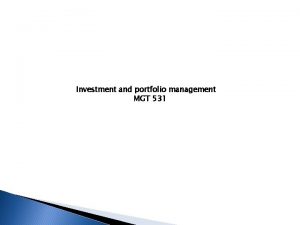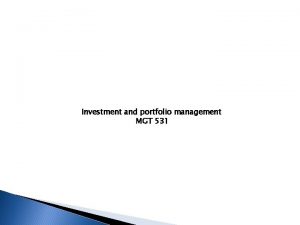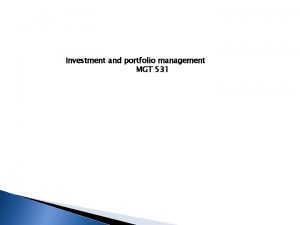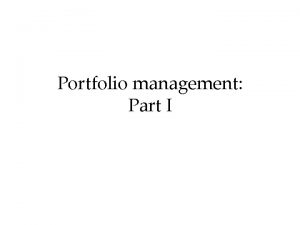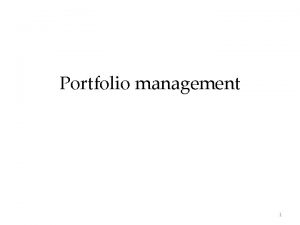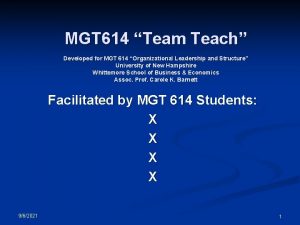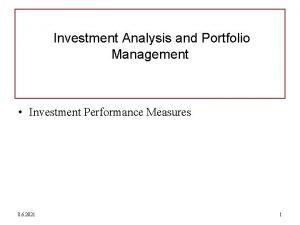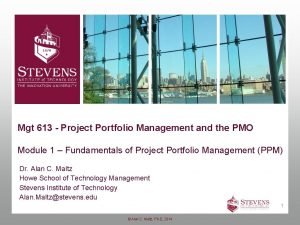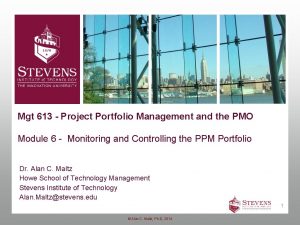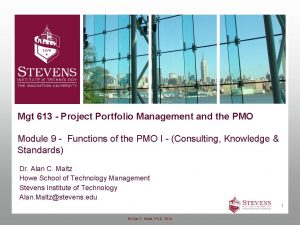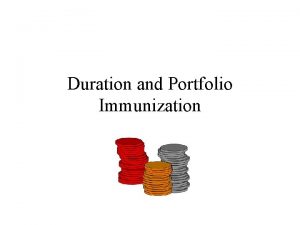Investment and portfolio management MGT 531 Investment and



















































- Slides: 51

Investment and portfolio management MGT 531

Investment and portfolio management • The course assumes little prior applied knowledge in the area of finance. • References • Kristina (2010) ‘Investment Analysis and Portfolio Management’, • University, Kaunas, Lithuania

Lecture # 5 Summary of the last lecture: Financial markets 1. Primary market and 2. Secondary market, 3. characteristics, 4. exchange TODAYS CONETNTS 1. Financial markets 2. Secondary market

Financial market • Exchanges play very important role in the modern economies by performing the following tasks: • Supervision of trading to ensure fairness and efficiency; • The authorization and regulation of market participants such as brokers and market makers; • Creation of an environment in which securities’ prices are formed efficiently and without distortion. § They not only do regulation of orders and transaction costs but also a liquid market in which there are many buyers and sellers, allowing investors to buy or to sell their securities quickly; • Organization of the clearing and settlement of transactions;

Financial market • The regulation of the admission of companies to be listed on the exchange and the regulation of companies who are listed on the exchange; • The dissemination of information (trading data, prices and announcements of companies listed on the exchange). • This is so because investors are more willing to trade if prompt and complete information is available. 1. about trades in the market and; 2. prices in the market

Financial market • The over-the-counter (OTC) market is not a formal exchange. • It is organized network of brokers and dealers who negotiate sales of securities. • There are no membership requirements and many brokers register as dealers on the OTC. • At the same time there are no listing requirements and thousands of securities are traded in the OTC market.

Financial market • OTC stocks are usually considered as very risky because; • they are the stocks that are not considered large or stable enough to trade on the major exchange. • An alternative trading system (ATS) is an electronic trading mechanism developed independently from the established market places – security exchanges. • Are designed to match buyers and sellers of securities on an agency basis. • The brokers who use ATS are acting on behalf of their clients and do not trade on their own account. •

Financial market • The distinct advantages of ATS in comparison with traditional markets are: 1. cost savings of transactions, 2. the short time of execution of transactions for liquid securities. 3. extended hours for trading and secrecy, § often important for investors, who are trading large amounts

Financial market Second characteristics of financial market • Term of circulation of financial assets traded in the market: • Money market; • Capital market • Money market - in which only short-term financial instruments are traded. • Capital market - in which only long-term financial instruments are traded. • The capital markets allow firms, governments to finance spending in excess of their current incomes.

The comparison of money market and capital market Features Money market Capital market Term of circulation of securities traded Short-term, less than 1 year Long-term, more than 1 year Level of risk Low, because of trading Long-term securities, short-term securities which traded in this market, is have lower level of risk more risky and high liquidity Fund suppliers Commercial banks, nonfinancial business institutions with the excess funds Banks, insurance companies, pension funds, lending the large amounts of funds for a long-term period; investment funds with big pools of funds for investing

The comparison of money market and capital market Features Money market Capital market Financial instruments Certificates of deposit; Treasury bills; Commercial paper; Bankers’ acceptances; Repurchase agreements, other short-term investment vehicles Common stocks; Preferred stocks; Treasury bonds; Municipal bonds; Corporate bonds; other long-term investment vehicles Aims for raising money For financing of working capital and current needs For financing of further business development and investment projects

Financial market • • • Third characteristics of financial market Economic nature of securities, traded in the market: Equity market or stock market; Common stock market; Fixed-income market; Debt market; Derivatives market. From the perspective of a given country. financial markets are: Internal or national market; External or international market. The internal market can be split into two fractions: domestic market and foreign market.

Financial market • Domestic market is where the securities issued by domestic issuers (companies, Government) are traded. • A country’s foreign market is where the securities issued by foreign entities are traded. 1. The external market also is called the international market includes the securities which are issued at the same time to the investors in several countries and; 2. they are issued outside the rule of any single country (for example, offshore market).

Investment management process • Investment management process is the process of managing money or funds. • The investment management process describes how an investor should go about making decisions. • Investment management process can be disclosed by five-step procedure, • which includes following stages: • 1. Setting of investment policy. • 2. Analysis and evaluation of investment vehicles. • 3. Formation of diversified investment portfolio. • 4. Portfolio revision • 5. Measurement and evaluation of portfolio performance.

Investment policy 3. Globalization of financial markets • Globalization and integration processes include the integration of financial markets into an international financial market. • Because of the globalization of financial markets, potential issuers and investors in any country become not limited to their domestic financial market. • Setting of investment policy is the first and very important step in investment management process. • Investment policy includes setting of investment objectives. • The investment policy should have the specific objectives regarding the investment return requirement and risk tolerance of the investor. • .

Investment policy • For example, the investment policy may define that the target of the investment average return should be 15% and should avoid more than 10% losses • Identifying investor’s tolerance for risk is the most important objective, because it is obvious that every investor would like to earn the highest return possible. • But because there is a positive relationship between risk and return, it is not appropriate for an investor to set his/ her investment objectives as just “to make a lot of money”. • Investment objectives should be stated in terms of both risk and return.

Investment policy • The investment policy should also state other important constrains which could influence the investment Management. • Constrains can include: • any liquidity needs for the investor during projected investment horizon, as well as other unique needs and preferences of investor. • The investment horizon is the period of time for investments. • Projected time horizon may be short, long or even indefinite.

Investment policy • Setting of investment objectives for individual investors is based on the assessment of their current and future financial objectives. • The required rate of return for investment depends on what sum today can be invested and how much investor needs to have at the end of the investment horizon. • Wishing to earn higher income on his / her investments, investor must assess the level of risk he /she should take and to decide if it is relevant for him or not. • The investment policy can include the tax status of the investor.

Investment policy • This stage of investment management concludes with the identification of the potential categories of financial assets for inclusion in the investment portfolio. • The identification of the potential categories is based on: 1. the investment objectives, 2. amount of investable funds, 3. investment horizon and 4. tax status of the investor.

Analysis and evaluation of investment vehicles • When the investment policy is set up, investor’s objectives defined and the potential categories of financial assets for inclusion in the investment portfolio identified, the available investment types can be analyzed. • This step involves examining several relevant types of investment vehicles and the individual vehicles inside these groups. • For example, if the common stock was identified as investment vehicle relevant for investor, the analysis will be concentrated to the common stock as an investment. • The one purpose of such analysis and evaluation is to identify those investment vehicles that currently appear to be mispriced.

Analysis and evaluation of investment vehicles • There are many different approaches how to make such analysis. Most frequently two forms of analysis are used: • technical analysis and • fundamental analysis. 1) Technical analysis involves the analysis of market prices in an attempt to predict future price movements for the particular financial asset traded on the market. • This analysis examines the trends of historical prices and is based on the assumption that these trends or patterns repeat themselves in the future.

Analysis and evaluation of investment vehicles 2). Fundamental analysis in its simplest form is focused on the evaluation of intrinsic value of the financial asset. • This valuation is based on the assumption that intrinsic value is the present value of future flows from particular investment. • By comparison of the intrinsic value and market value of the financial assets those which are under priced or overpriced can be identified.

Formation of diversified investment portfolio • This step involves identifying those specific financial assets in which to invest and determining the proportions of these financial assets in the investment portfolio. • Formation of diversified investment portfolio is the next step in investment management process. • Investment portfolio is the set of investment vehicles, formed by the investor seeking to realize its’ defined investment objectives. • In the stage of portfolio formation: 1. the issues of selectivity, 2. timing and 3. diversification need to be addressed by the investor. • Selectivity refers to micro forecasting and focuses on forecasting price movements of individual assets.

Formation of diversified investment portfolio • Timing involves macro forecasting of price movements of particular type of financial asset relative to fixed-income securities in general. • Diversification involves forming the investor’s portfolio for decreasing or limiting risk of investment. • There are Two techniques of diversification: 1. Random diversification, when several available financial assets are put to the portfolio at random; 2. objective diversification when financial assets are selected to the portfolio following: § investment objectives and § using appropriate techniques for analysis and § evaluation of each financial asset.

Formation of diversified investment portfolio • Investment management theory is focused on issues of objective portfolio diversification and • professional investors follow settled investment objectives then constructing and managing their portfolios. • Portfolio revision. This step of the investment management process concerns the periodic revision of the three previous stages. This is necessary, because over time investor with long-term investment horizon may change his / her investment objectives • and this, in turn means that currently held investor’s portfolio may no longer be optimal and even contradict with the new settled investment objectives. • Investor should form the new portfolio: 1. by selling some assets in his portfolio and 2. buying the others that are not currently held.

Formation of diversified investment portfolio • It could be the other reasons for revising a given portfolio: over time the prices of the assets change, meaning that some assets that were attractive at one time may be no longer be so. • Thus investor should sell one asset and buy the other more attractive in this time according to his/ her evaluation. • The decisions to perform changes in revising portfolio depend, upon other things, in the transaction costs incurred in making these changes. • For institutional investors portfolio revision is continuous and very important part of their activity. • But individual investor managing portfolio must perform portfolio revision periodically as well. • Periodic re-evaluation of the investment objectives and portfolios based on them is necessary, because financial markets change, tax laws and security regulations change, and other events alter stated investment goals.

Measurement and evaluation of portfolio performance. • This the last step in investment management process involves determining periodically how the portfolio performed, in terms of not only the return earned, but also the risk of the portfolio. • For evaluation of portfolio performance appropriate measures of return and risk and benchmarks are needed. • A benchmark is the performance of predetermined set of assets, obtained for comparison purposes. • The benchmark may be a popular index of appropriate assets – stock index, bond index. • The benchmarks are widely used by institutional investors evaluating the performance of their portfolios.

Portfolio performance • It is important to point out that investment management process is continuing process influenced by changes in investment environment and changes in investor’s attitudes as well. • Market globalization offers investors new possibilities, but at the same time investment management become more and more complicated with growing uncertainty.

Summary • 1. The common target of investment activities is to “employ” the money (funds) during the time period seeking to enhance the investor’s wealth. • 2. Direct investing is realized using financial markets and indirect investing involves financial intermediaries. • 3. Investment environment can be defined as the existing investment vehicles in the market available for investor and the places for transactions with these investment vehicles. • 4. The most important characteristics of investment vehicles on which bases the overall variety of investment vehicles can be assorted are the return on investment and the risk.

Summary • The main types of financial investment vehicles are: short- term • investment vehicles; fixed-income securities; common stock; speculative investment vehicles; other investment tools. • 6. Financial markets are designed to allow corporations and governments to raise new funds and to allow investors to execute their buying and selling orders. • 7. All securities are first traded in the primary market, and the secondary market provides liquidity for these securities. Primary market is where corporate and government entities can raise capital and where the first transactions with the new issued securities are performed. Secondary market - where previously issued securities are traded among investors. Generally, individual investors do not have access to secondary markets. They use security brokers to act as intermediaries for them.

Summary • 8. Financial market, in which only short-term financial instruments are traded, is Money market, and financial market in which only long -term financial instruments are traded is Capital market. • 9. The investment management process describes how an investor should go about making decisions. • 10. Investment policy includes setting of investment objectives regarding the investment return requirement and risk tolerance of the investor. The other constrains which investment policy should include and which could influence the investment management are any liquidity needs, projected investment horizon and preferences of the investor. • 11. Investment portfolio is the set of investment vehicles, formed by the investor seeking to realize its’ defined investment objectives. Selectivity, timing and diversification are the most important issues in the investment portfolio formation. • Diversification involves forming the investor’s portfolio for decreasing or limiting risk of investment.

Questions and problems • • • • • 1. Distinguish investment and speculation. 2. Explain the difference between direct and indirect investing. 3. How could you describe the investment environment? 4. Classify the following types of financial assets as long-term and short term: a) Repurchase agreements b) Treasury Bond c) Common stock d) Commercial paper e) Preferred Stock f) Certificate of Deposit 5. Comment the differences between investment in financial and physical assets using following characteristics: a) Divisibility b) Liquidity c) Holding period d) Information ability 6. Why preferred stock is called hybrid financial security?

2. Quantitative methods of investment analysis • Mini-contents • 1. Investment income and risk. • 2. Return on investment and expected rate of return. • 3. Investment risk. Variance and standard deviation. • 4. Relationship between risk and return. • 4. 1. Covariance • 4. 2. Correlation and Coefficient of determination. • 4. 3. Relationship between the returns on asset and market portfolio • 4. 4 The characteristic line and the Beta factor.

Quantitative methods of investment analysis • Investment income and risk • A return is the ultimate objective for any investor. • But a relationship between return and risk is a key concept in finance. • As finance and investments areas are built upon a common set of financial principles, the main characteristics of any investment are investment return and risk. • However to compare various alternatives of investments the precise quantitative measures for both of these characteristics are needed.

Return on investment and expected rate of return • General definition of return is the benefit associated with an investment. • In most cases the investor can estimate his/ her historical return precisely. • Many investments have two components of their measurable return: 1) a capital gain or loss; 2) some form of income. • The rate of return is the percentage increase in returns associated with the • holding period: • Rate of return = Income + Capital gains / Purchase price (%) (1)

Return on investment and expected rate of return • For example, rate of return of the share (r) will be estimated: • (2) • Here D - dividends; • Pmb - market price of stock at the beginning of holding period; • Pme - market price of stock at the end of the holding period. • The rate of return, calculated in formulas (1) and (2) is called holding period return, because its calculation is independent of the passages of the time. • All the investor knows is that there is a beginning of the investment period an end.

Return on investment and expected rate of return • The percent calculated using this formula might have been earned over one month or other the year. • Investor must be very careful with the interpretation of holding period returns in investment analysis. • Investor can‘t compare the alternative investments using holding period returns, if their holding periods (investment periods) are different. • Statistical data which can be used for the investment analysis and portfolio formation deals with a series of holding period returns. • For example, investor knows monthly returns for a year of two stocks. How he/ she can compare these series of returns?

Return on investment • In these cases arithmetic average return or sample mean of the returns (Ri) can be used: But both holding period returns and sample mean of returns are calculated. • Eq (3) • But both holding period returns and sample mean of returns are calculated using historical data. • However what happened in the past for the investor is not as important as what happens in the future, because all the investors‘ decisions are focused to the future, or to expected results from the investments.

Return on investment • Of course, no one investor knows the future, but he/ she can use past information and the historical data as well as to use his knowledge and practical experience to make some estimates about it. • Analyzing each particular investment vehicle possibilities to earn income. • In the future investor must think about several „scenarios“ of probable changes in macro economy, industry and company which could influence asset prices ant rate of return.

• Theoretically it could be a series of discrete possible rates of return in the future for the same asset with the different probabilities of earning the particular rate of return. • But for the same asset the sum of all probabilities of these rates of returns must be equal to 1 or 100 %. • In mathematical statistics it is called simple probability distribution.

Expected rate of return • The expected rate of return E(r) of investment is the statistical measure of return, which is the sum of all possible rates of returns for the same investment weighted by probabilities: Equation (4) • Here hi - probability of rate of return; • ri - rate of return. • In all cases than investor has enough information for modeling of future scenarios of changes in rate of return for investment, the decisions should be based on estimated expected rate of return.

• But sometimes sample mean of return (arithmetic average return) are a useful proxy for the concept of expected rate of return. • Sample mean can give an unbiased estimate of the expected value, but obviously it‘s not • perfectly accurate, because based on the assumption that the returns in the future will be the same as in the past. • But this is the only one scenario in estimating expected rate of return. • It could be expected, that the accuracy of sample mean will increase, as the size of the sample becomes longer (if n will be increased). • However, the assumption, that the underlying probability distribution does not change its shape for the longer period becomes more and more unrealistic.

Expected rate of return • • • In general, the sample mean of returns should be taken for as long time, as investor is confident there has not been significant change in the shape of historical rate of return probability distribution. Investment risk Risk can be defined as a chance that the actual outcome from an investment will differ from the expected outcome. Obvious, that most investors are concerned that the actual outcome will be less than the expected outcome. The more variable the possible outcomes that can occur, the greater the risk. Risk is associated with the dispersion in the likely outcome. And dispersion refers to variability. So, the total risk of investments can be measured with such common absolute measures used in statistics as • variance; • standard deviation.

Expected rate of return • Variance can be calculated as a potential deviation of each possible investment rate of return from the expected rate of return: Equation (5) • To compute the variance in formula Equation (5) all the rates of returns which were observed in estimating expected rate of return (ri) have to be taken together with their probabilities of appearance (hi).

standard deviation • The other an equivalent to variance measure of the total risk is standard deviation which is calculated as the square root of the variance: • Square root of the following equation is:

sample variance • In the cases than the arithmetic average return or sample mean of the returns • (ř) is used instead of expected rate of return, sample variance can be calculated: • Sample standard deviation (δr) consequently can be calculated as the square root of the sample variance:

Variance • Variance and the standard deviation are similar measures of risk and can be used for the same purposes in investment analysis; • however, standard deviation in practice is used more often. • Variance and standard deviation are used when investor is focused on estimating total risk that could be expected in the defined period in the future. • Sample variance and sample standard deviation are more often used when investor evaluates total risk of his /her investments

Relationship between risk and return • The expected rate of return and the variance or standard deviation provide investor with information about the nature of the probability distribution associated with a single asset. • However all these numbers are only the characteristics of return • and risk of the particular asset. • But how does one asset having some specific trade-off between return and risk influence the other one with the different characteristics of return and risk in the same portfolio? • And what could be the influence of this relationship to the investor’s portfolio? • The answers to these questions are of great importance for the investor when forming his/ her diversified portfolio.

Relationship between risk and return • • • The statistics that can provide the investor with the information to answer these questions are covariance and correlation coefficient. Covariance and correlation are related and they generally measure the same phenomenon – the relationship between two variables. Both concepts are best understood by looking at the math behind them. Two methods of covariance estimation can be used: the sample covariance and the population covariance. The sample covariance is estimated than the investor hasn‘t enough information about the underlying probability distributions for the returns of two assets and then the sample of historical returns is used.

• Sample covariance between two assets - A and B is defined later. • • • here r. A, t , r. B, t - consequently, rate of return for assets A and B in the time period t, when t varies from 1 to n; ŕA, ŕB - sample mean of rate of returns for assets A and B consequently. As can be understood from the formula, a number of sample covariance can range from “–” to “+” infinity. Though, the covariance number doesn’t tell the investor much about the relationship between the returns on the two assets if only this pair of assets in the portfolio is analysed. It is difficult to conclud if the relationship between returns of two assets (A and B) is strong or weak, taking into account the absolute number of the sample variance. However, what is very important using the covariance for measuring relationship between two assets – the identification of the direction of this relationship. Positive number of covariance shows that rates of return of two assets are moving to the same direction: when return on asset A is above its mean of return (positive), the other asset B is tend to be the same (positive) and vice versa: when the rate of return of asset A is negative or bellow its mean of return, the returns of other asset tend to be negative too.

• Negative number of covariance shows • that rates of return of two assets are moving in the contrariwise directions: when return • on asset A is above its mean of return (positive), the returns of the other asset - B is • tend to be the negative and vice versa. Though, in analyzing relationship between the • assets in the same portfolio using covariance for portfolio formation it is important to • identify which of the three possible outcomes exists:
 Investment analysis and portfolio management
Investment analysis and portfolio management Scope of investment analysis and portfolio management
Scope of investment analysis and portfolio management Investment analysis and portfolio management course
Investment analysis and portfolio management course 531 area code
531 area code Onap network slicing
Onap network slicing Cpsc 531
Cpsc 531 Cpsc 531
Cpsc 531 Cpsc 531
Cpsc 531 Cpsc 531
Cpsc 531 Concentration camps vs internment camps venn diagram
Concentration camps vs internment camps venn diagram Amg 531
Amg 531 Cse 531
Cse 531 Investment analysis & portfolio management
Investment analysis & portfolio management Fixed investment and inventory investment
Fixed investment and inventory investment Student portfolio examples pdf
Student portfolio examples pdf Mgt 323
Mgt 323 Management accounting scope
Management accounting scope Mgt 601
Mgt 601 Mgt 351 nsu course outline
Mgt 351 nsu course outline Mgt 340 assignment
Mgt 340 assignment Mgt 321 chapter 2
Mgt 321 chapter 2 Mgt 211
Mgt 211 Mgt 211
Mgt 211 Mgt 411
Mgt 411 Mgt 385
Mgt 385 Mgt 613
Mgt 613 Mgt502
Mgt502 Mgt-130
Mgt-130 Retail financial strategy
Retail financial strategy K12 asset mgt
K12 asset mgt Mgt 610
Mgt 610 Mgt 601
Mgt 601 Importance of joint stock company
Importance of joint stock company Meaning of mgt
Meaning of mgt Mgt 610
Mgt 610 Mgt 610
Mgt 610 Rs1.sze.hu baloght
Rs1.sze.hu baloght Mgt 501
Mgt 501 Mgt 501
Mgt 501 Mgt 3
Mgt 3 Mgt 501
Mgt 501 Mgt 385
Mgt 385 Securing the human
Securing the human Wayne smith csun
Wayne smith csun The size of sme is assessed through: mgt601
The size of sme is assessed through: mgt601 Microsoft update
Microsoft update Mgt 535
Mgt 535 Mgt-130
Mgt-130 Security analysis and portfolio management project
Security analysis and portfolio management project Security analysis and portfolio management project
Security analysis and portfolio management project Hp project management
Hp project management Ppm tools gartner magic quadrant
Ppm tools gartner magic quadrant





